|
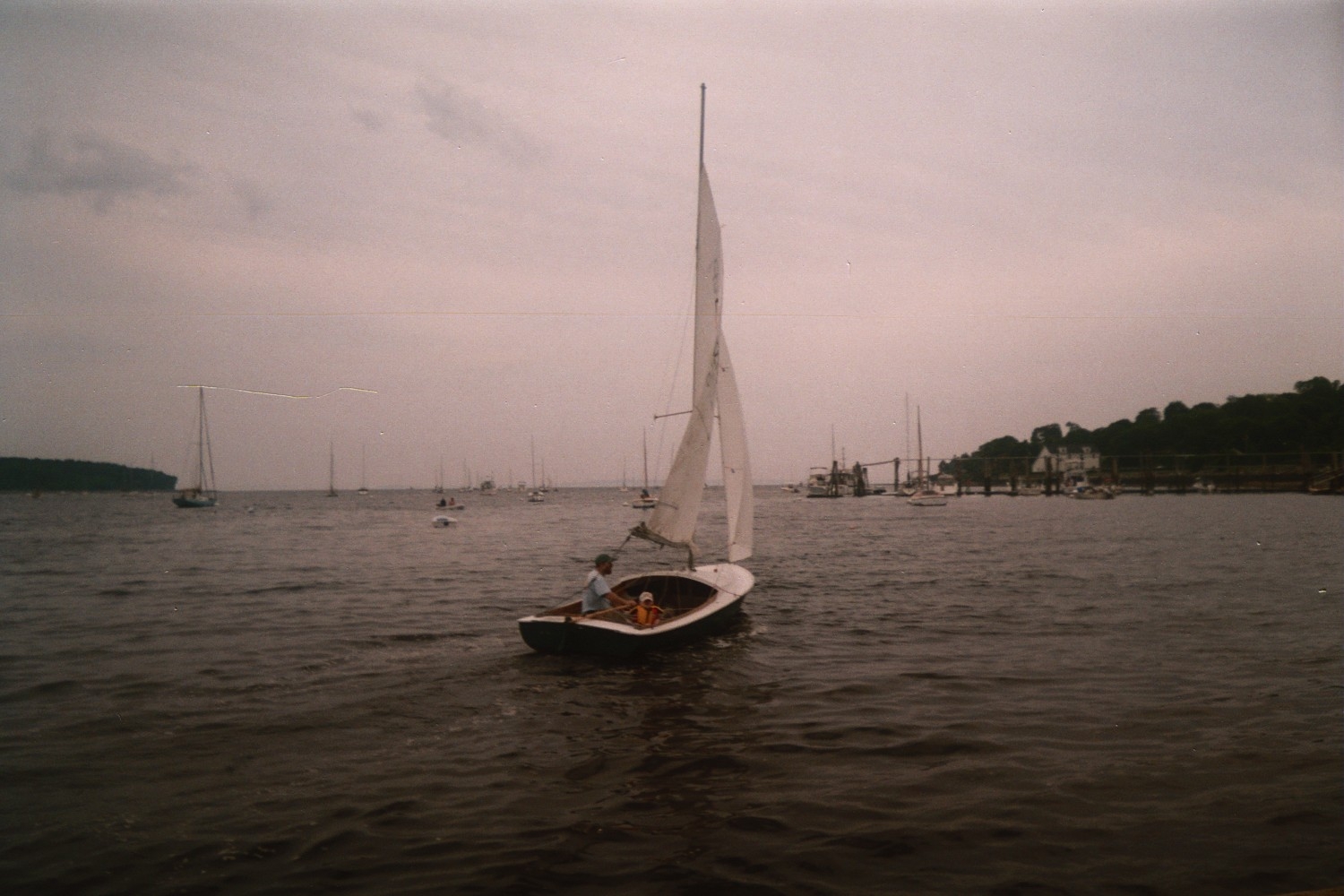
|
| Underway in Belfast Harbor |
Update: July 2006
I was going to build a boat this summer, but I found that I did not have the time,
tools or money. I looked in the classified ads and found an O'Day Daysailer with a trailer at a good price, and bought her.
I named her Marsh Hawk because she is so fast and I love sailing around in marshes. She was built some time in the sixties,
hull #1276, and is sound as could be, and her sails are new. She came with a canoe paddle which was intended to be used as
a boom crutch, but which also serves as auxiliary power when the wind dies.
I have had her out every day since I bought her. I launched her on the Fourth
of July in zero visibility and 15 to 20 knot winds and light mist an hour after sundown, and zipped around the harbor reefed
down for a bit, just to get a feel of her. Next morning I packed up my son David, just turned three, and took off down
river for Stockton Harbor. The wind was light and variable, and died out altogether from time to time, but it was blowing
steady enough when I made the dock in Stockton and handed the boy off to Abigail who drove to meet us there. I decided
to try to sail back to Belfast. Big mistake; I got as far as the south end of Sears Island where I was becalmed and adrift
for an hour before I gave up and paddled back to Stockton, pursued by thousands of mosquitos.
The following morning I left
Stockton paddling in a calm, but picked up a little breeze and sailed across the bay to Bayside, where there are a number
of Daysailers moored off the beach.
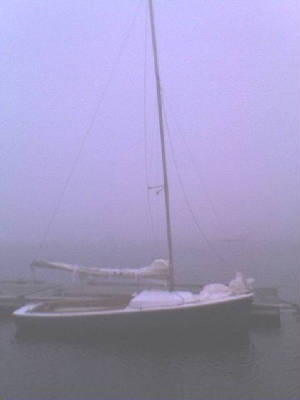
|
| July 4th, zero visibility |
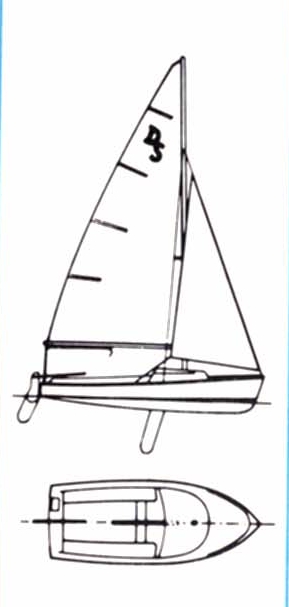
|
| O'Day Day Sailer 17 |
I returned to Belfast and hauled the boat overnight, then launched her in the morning
and again with David for crew, set off on an expedition to Searsport to see the Penobscot Maritime Museum. Abigail met us
there and we toured some of the place, finding it excellent but too much to see in a day especially with a baby in tow. The
best was the boatshed with George Wasson's old sloop he lived aboard when he wrote "Sailing Days on the Penobscot".
On the way home I overtook a Cape Dory 25 heading into Belfast and we sailed in company
for a little while, admiring each others boats and exchanging compliments. I was able to keep pace with her in the light winds
despite being reefed, which shows just how fast the Daysailer is. I kept the reef in the first few times out just to avoid
any unexpected knockdowns or anything that would scare the baby while I was getting used to the boat.
I had her out again today for a couple of short sails, and tomorrow will pack her
up on the trailer for a couple of weeks while I go back to work towing barges around New York Harbor. All in all, this is
the best boat I have had so far. She is perfect for the kind of sailing which I most enjoy, lively yet stable enough for the
baby; and capable of exploring the shallows and drying out, if need be, in an upright position.

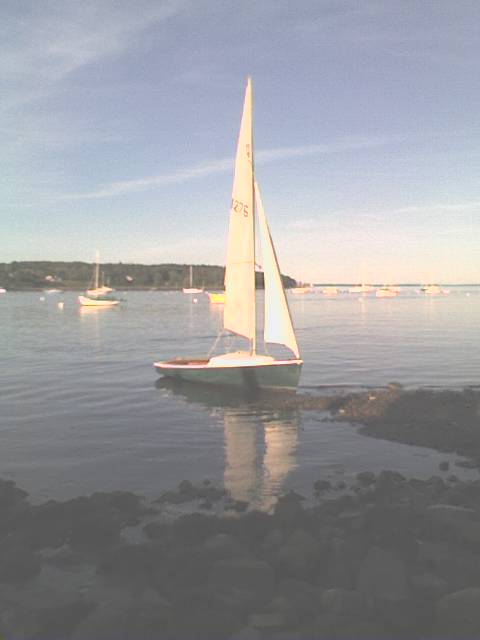
|
| On the beach at Belfast |
Update: August 2006
My crew has let it be known that rather than going on longer trips under sail, he
would prefer, for the time being, to just knock around the harbor and practice landing on the beaches. So, we have fallen
into a routine where we sail in the morning, till naptime, then I bring him ashore and, if time allows, go for a longer sail
myself in the afternoon.
The longest sail so far has been to Castine and back. I was becalmed most of the
way there, and drifted along in company with a beautiful old wooden sloop who remained for most of the trip about three
hundred yards off my starboard quarter. I decided at one point to tack in anticipation of a wind shift, and came to a
dead stop; while the wooden boat, with her lead keel, coasted along through the lull and came to rest a half mile off my port
bow. We sat there for half an hour till the wind shift finally came, then I almost caught up to her, running fast with the
new breeze, till her sails filled and she was off on a broad reach at speed.
I hiked out and used my tiller extention and did everything else I could think of,
but never could quite catch her, so I turned into the harbor at Castine and tied up to the dock to get a sandwich. On the
way home to Belfast I had to reef, and made good time across the bay on a run till the wind shifted again then died away,
and I ended up the trip with my canoe paddle and no wind at all. Still got back more or less in time for dinner.

|
| The crew giving orders |
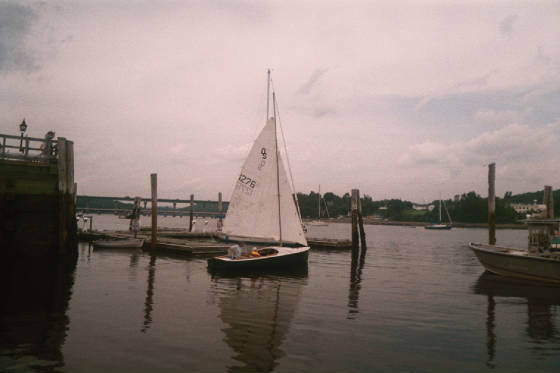
|
| Sailing off the dock |
Update: Sept. 2006
Since moving here, I've wanted to make a trip up the Orland River. It is a small
branch off the Penobscot Eastern Channel just south of Bucksport. It is a very scenic river, and at low tide it has practically
no water in it, and none at all at the head of navigation, up by the dam. I sailed out of Belfast a few hours after low tide,
with a southeast wind which veered south then west as I made my way upriver with the flood. All the forces of nature cooperated
to make a perfect days sail, a cool fair breeze, warm sunlight, crisp dry air, and a fair tide. I arrived at the dam at slack
high water, then turned and leisurely sailed back the way I came with the start of the ebb. The wind obligingly veered northwest
as I passed the southern tip of Verona Island, and I ran downriver with the tide past Fort Point on Cape Jellison. There was
a swift current running between the point and the ledge, and I was glad I had it with me and nice weather. I sailed back into
the dock at Belfast some nine hours after I'd left, tired and happy.

|
| The crew prepares to get underway |
My crew has enjoyed towing the bailer behind the sailboat, and pretending
it was a dinghy; so I thought I'd make him a proper towing skiff instead. I used a proven design: the John Gardner inspired
clamming skiff I'd built for my own use some years back, but built this time to a scale of 2"= 1'. In other words 24"
for a 12' skiff. I decked it mostly over so that it wouldn't sink, but it rides as dry as could be wished in seas all out
of proportion to its size, and at speeds which if figured to scale must sometimes exceed 30 kts.

I have very much enjoyed sailing in a boat which, in the event of the
wind falling calm, can be propelled easily with a canoe paddle. The paddle which came with the boat had been modified to act
as a boom crutch, and since this made it uncomfortable to use, I went to Hamilton's marine store and got myself a new one.
I was hoping, in the back of my mind, that I would get a chance to use it, and the occasion presented itself during my attempted
daysail to Lincolnville, which daysail turned almost into an expedition.
I left belfast on a falling tide and made my way southward running with
a light northeast wind which was forcast to veer east and freshen in the afternoon, and which I figured would then give me
a fair breeze home. However, the wind failed altogether by the time I reached Bayside. This was my chance to paddle, and I
made the best of it, paddling as far as Northport before the wind returned, some three miles. This took about two hours, so
a knot and a half was made good paddling.
Once I had some wind I sailed across the river and between Seal Island and Flat Island
and rounded up into Seal Harbor, where I found myself taking a reef before proceeding down to Ducktrap Harbor and Lincolnville.
Here I had some pizza and met Abigail and David, whom I'd hoped to take for a sail to Islesboro; but David was adamant in
his refusal to go. So, we played on the beach at Lincolnville a little while before I set off for home.
The wind faded away, the tide turned foul, and it got dark. Soon I was paddling vigorously
to get out of the shipping lane and out of the way of an outbound tanker. I threaded my way in among the rocks and ledges
of Sprague Cove, which hazards are marked, in lieu of nuns and cans, with a colony of seals croaking and grunting to warn
off the unwary traveller. All that night I paddled here and there searching for a breath of wind, but there was no wind to
be found. I tied to a mooring buoy off Bayside around midnight and had a nap, but soon awoke chilled and damp from the dew.
I hefted my paddle and at length arrived in Belfast just before the dawn, twenty hours after my departure.

Update: Sept 2006
I made a few daysails this month, one with my mom aboard as well as my son, three
generations in the same boat. Mom was impressed, but David napped the whole time, only waking up at the end and insisting
he be put ashore immediately. I landed him on the beach with Mom, and Abigail arrived to take my passengers home while I sailed
to the dock.
The expedition I had in mind, a circumnavigation of Islesboro Island, was not to
be. I got a late start and the wind fell light by the time I had gotten partway around Turtle Head on the northern end of
the island, so I landed on the beach at Parker Cove and took some pictures, then sailed across to Castine to get a sandwitch.
On the way home the breeze came up and before I knew it I had way too much sail. I tried reefing the main without first dropping
the jib, with the result that I found myself broadside to the seas, rail under and in some danger of capsize. I put the helm
down and luffed, got the jib down right quickly and then finished reefing the main. I will remember that the first sail reduction
on this boat is take down the jib.
After that I flew across the bay under reefed main alone, still too much sail, but
controllable. I will have to get another set of reef points and maybe a storm jib. Sailing singlehanded, this is a lot of
boat to keep upright on a broad reach when a breeze comes up. Nonetheless, I kept pace with a much larger boat carrying whole
sail and a 150% genoa all the way back to Belfast.

|
| On the beach at Parker Cove |

|
| The ramp at Belfast Harbor |
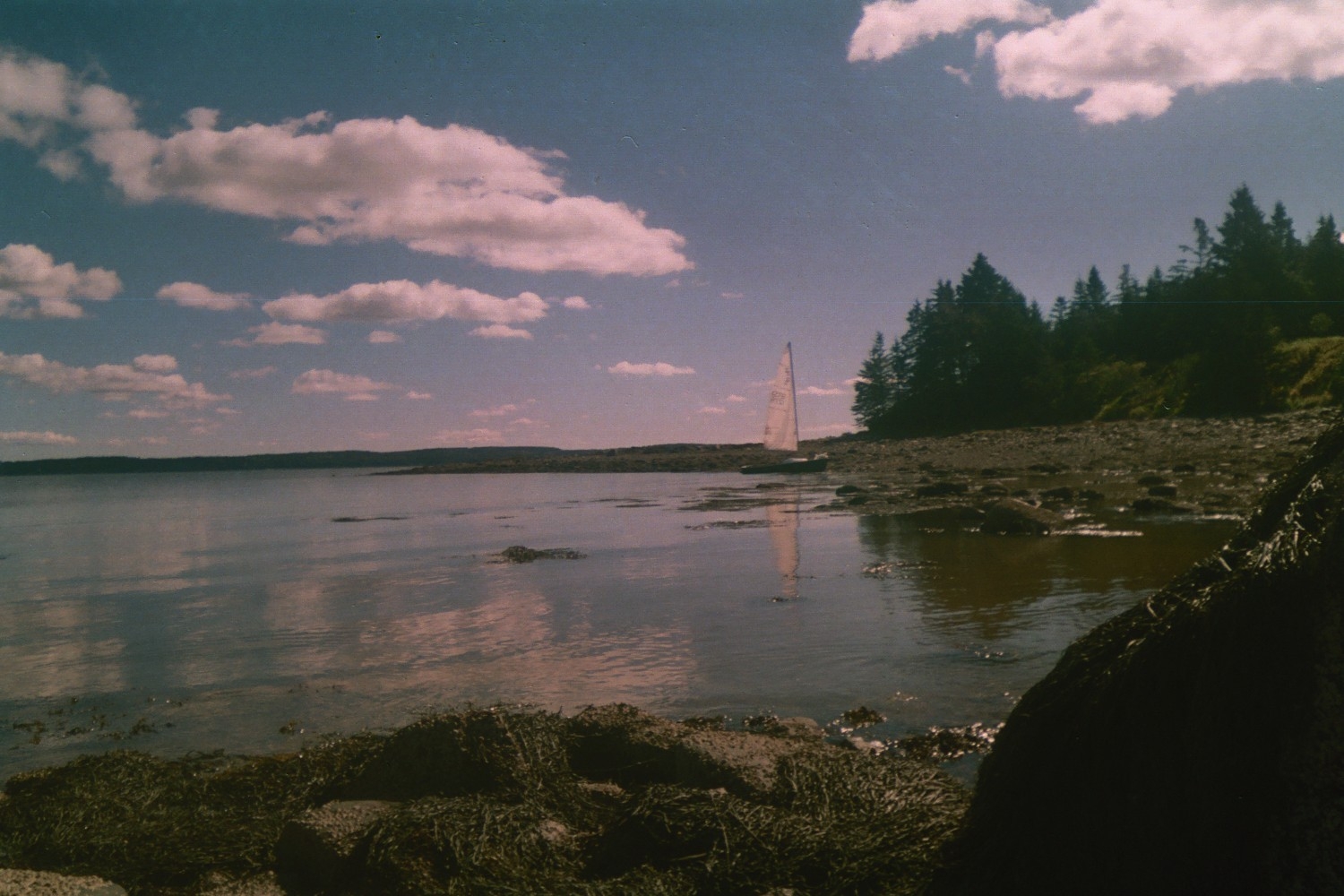
|
| Marsh Hawk at Hutchins Island |
Update: 30 October 2006
The wind blew hard for two weeks, half a gale, then a gale, then a storm, and so on, not one day’s
forecast was for anything like conditions in which I would feel comfortable out on the bay in the Day Sailor. This is a rough
time of year, the change of the seasons, and this year has been an especially windy one. So, in the hope of making some good
use of the time, I turned to my ever growing list of boat projects.
The
first thing I did was to take my mainsail in to Pope Sails and Rigging in Rockland and have a second set of reef points put in. The last time I was out
I thought I might end up swimming home, even with the jib down and one reef in. The next thing I wanted to do was change the
jib sheeting system; the cam cleats that came with the boat have always annoyed me, needing two hands at times to belay them.
Also the stainless steel assembly was introducing an error into my steering compass. I installed two bronze cleats on the
thwart, one each side of the centerboard trunk. The cam cleats on the main sheet seem to work well enough, so I’ll leave
them alone for now. The jib sheet blocks I didn’t care for either. They were supposed to slide on tracks, but only one
side could be adjusted without using a wrench, though it seemed like a good enough position where it was. I replaced them
both with some little bronze blocks mounted on eye straps. I got rid of the tracks.
I mounted a padeye on the deck just abaft the mast to attach one end of a tackle for a boom vang. I haven’t settled
on where on the boom I want to attach the other end; I’m going to try attaching it at the same point as the main sheet
and see how it goes. I may end up moving it forward.
I built and installed a removable bed on the port side forward, up under
the deckhouse. I have had boats with sitting headroom, and with standing headroom, but I suppose I would have to describe
this one as scooting headroom, because there’s just room enough to scoot inside with a sleeping bag. Nonetheless this
will be a big improvement over sleeping all scrunched up on the floorboards. I don’t really intend to race, but I wanted
to make sure that I kept it light, so I used mahogany for the sides and ¼” plywood for the bed, supported by 1x2 strapping
athwartships.
The last project I completed was installing some oar locks and a rowing seat. The seat I made out of pine, just to
try it out and see how it worked. I like it well enough that I will build a nice one out of mahogany when I get a chance.
It’s shaped like a box top, and sits on the thwart over the new cleats and centerboard trunk. This is perhaps higher
in the boat than might be wished, but as things are arranged it’s the best I could do. I mounted the bronze oarlock
holders in blocks fixed to the deck outside the coamings, and besides giving me a good angle for the oars, they seem very
solid and strong, ready to take hard use if need be. After paddling back to Belfast
from Islesboro, I decided that nice as the canoe paddle is for maneuvering around tight spots, it really won’t do for
any long distance.
I hope that next month brings better sailing weather, a little less wind anyway, though I know it’s bound to
get cold.

|
| The bed also serves as a chart table. |
Update November 2006:
With the Thanksgiving holiday I didn't get to sail as much as I would have
otherwise, but I did get one good sail in with my stepdaughter Madeleine, who came up to visit. I had sailed out of Belfast
solo in a good breeze, and met Madeleine in Searsport around noon. The wind was backing from north to west, so I thought
I would sail across the bay and back to Belfast, just to show her the cliffs and lighthouse at Castine. The first part of
the plan worked well, but on the way back the wind fell light and we ended up becalmed off Sears Island. The temperature dropped
to 17 degrees, and my crew began to feel hypothermic, so she wrapped up in the sleeping bag in the new bunk and was soon warm,
except for her feet. I rowed into Searsport, and left the boat tied to the dock for the night. I came back alone
the next morning and set out for Belfast in a dead calm, first paddling then rowing. The oarlocks work well enough, but the
oars are too short by a foot. I will get some 7 footers, which should be just about right. After a while I got some wind and
sailed home on a broad reach. The new boom vang works fine; I can feel the boat speed up when I take up on the tackle.

|
| The floating dock at Searsport |

|
| 20 degrees and dropping... |
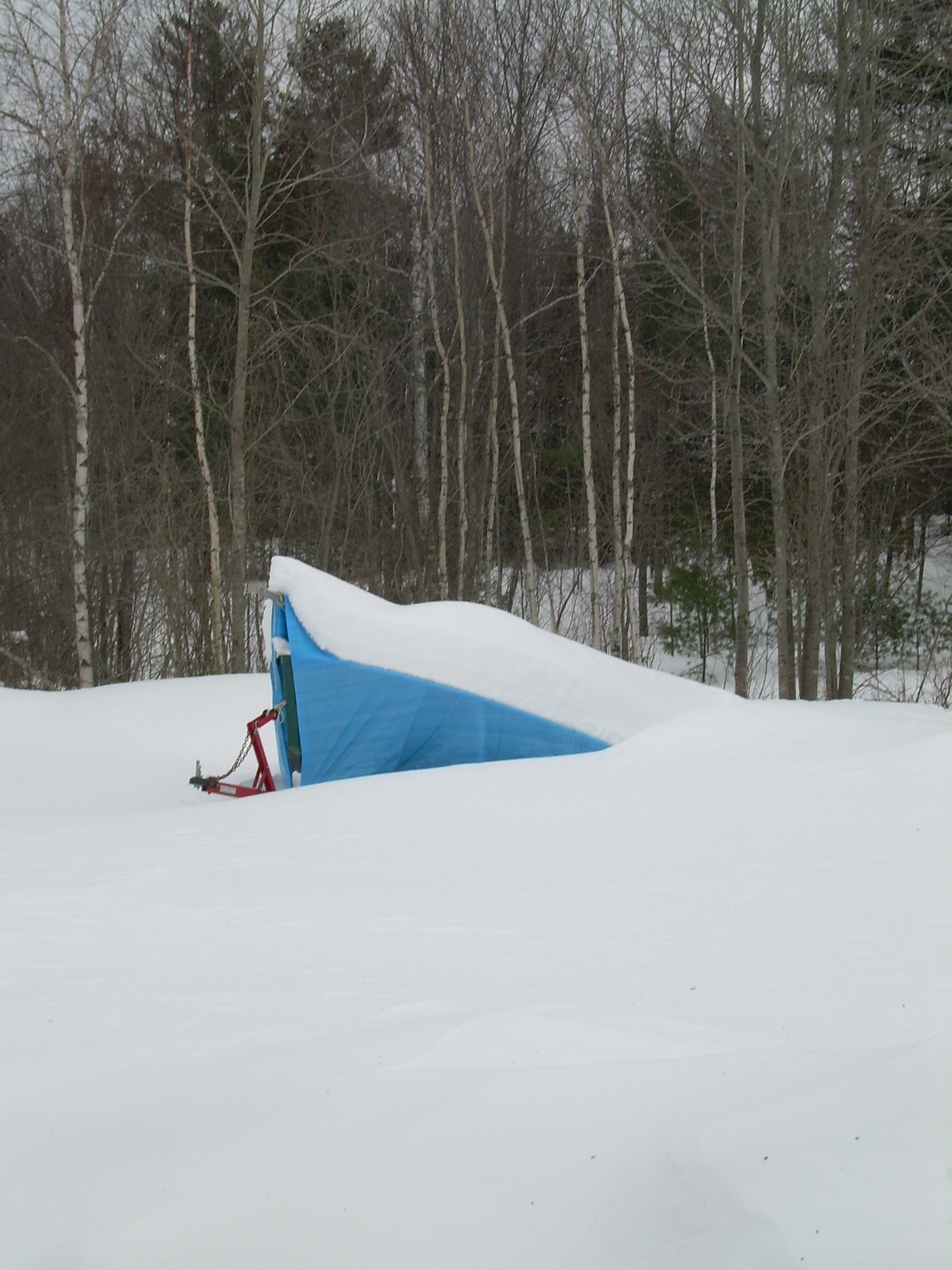
|
| The winter sailing season in Jackson Maine |
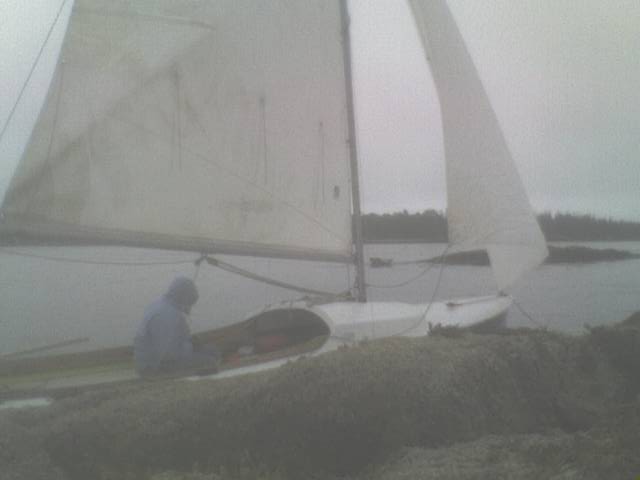
|
| Observing seals at Sprague Cove |
Update: June 2008
Hypothermia has become a theme for my daysails with my stepdaughter Madeleine. The
last time was 17 degrees, and this time although in the 50s and June, the drizzle and spray soaked us both through our shells
and sweats, and chilled us to the bone as we beat to windward down the bay. We had left Belfast on the first of the ebb tide
and sailed east toward Turtle Head, then south between Islesboro and the western shore in the hope of reaching Camden before
the tide turned. The visibility fell to some hundred yards, and once we had to tack out of the channel to avoid a northbound
tanker. The wind shifted between southeast and southwest, sometimes falling light, and then gusting back to fifteen knots
or so. It was the rain that finally got to us. With four or five miles to go, and an hour of fair tide left, I asked
Madeleine, "Are my lips blue?". "Yes," she replied. "Well so are yours," I said, "Lets turn back". The fair wind home was
a little less chilly, but too little comfort and too late. We observed seals and some kind of small black dolphins, and made
jokes about dying of exposure. Madeleine was a trooper, didn't complain once. Most people won't sail with me twice, but she
wants to go again. Makes me realize that dinghy cruising is much harder than keelboat, mostly because you don't carry your
shelter with you and exposure is a real danger. Once back ashore, we cranked up the car heater and got to feeling better presently.
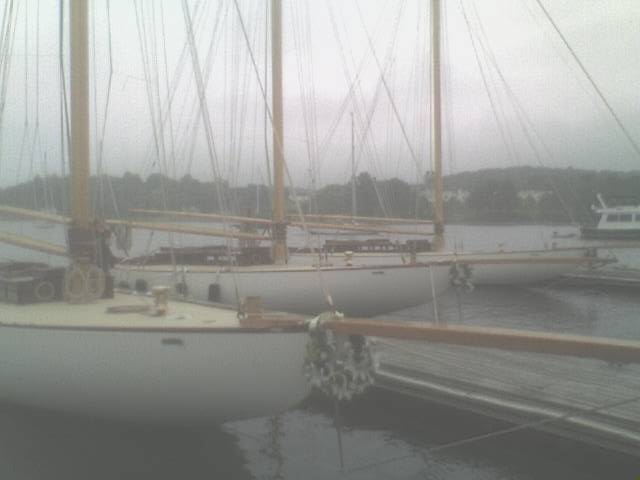
|
| NY 30s at Belfast Harbor. |
Update: June 2008
French and Webb, master boatbuilders of Belfast Me, have restored three Herreshoff New York 30s, and on Sunday had a
simultaneous three-boat launching party. I loaded up the Marshhawk and with my son David, daughter Madeleine, and niece Lily
for crew, got underway early at Searsport boat ramp and rowed south toward Moose Head, hoping for a breeze. It soon came and
by the time we got to Belast we were flying along under reefed main alone. We sailed to the dock and tied up, and I sent the
crew ashore for grub, as we'd forgotten our provisions in the car at Searsport. A great crowd had gathered for the occasion,
and three ladies smashed champagne bottles on the bowsprits at the same time, to much applause. Abby came and picked up the
little ones, and Madeleine and I sailed back to Searsport, Madeleine steering, and me napping in my bunk below. We hauled
out just before a thundersquall broke over the bay, and so avoided getting wet for once.
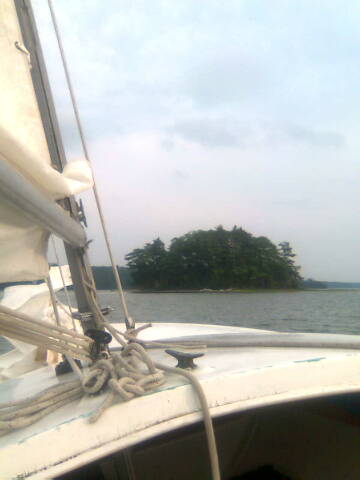
|
| Aunt Mollie Island |
Update: July 2008
Last sunday I sailed out of Belfast with the last of the ebb tide bound for Castine
and the Bagaduce River. The wind was gusting to 20 kts. out of the south and this made for a splashy close reach across the
bay. I had started out with full sail, but soon was down to reefed main and jib, then reefed main alone. By the time I reached
the mouth of the river by Dice Head, I wished I had reefed her twice, but I held on and flew past the docks with the
flood tide and on up the river. The current was strong and in no time I had reached the Narrows, where the water fairly boiled
around the rocks on both sides. I was caught in an eddy and becalmed in the lee of some pine trees; but by playing with my
centerboard and rudder I was able to steer her after a fashion, and on up the river I went. The Northern Bay is all a
mud flat at low water, but I had arrived just before high water and there was ten feet all around the islands and coves. This
is a beautiful area, old farmlands and forest, nothing to show if this was the 21st century or the 19th. I sailed around waiting
for the slack water, then made my way down river.
I had a fair tide presently and a good wind for a broad reach across the bay, but
night was falling pitch black and when I saw lightning ahead and heard the thunder I decided to be cautious. I turned around,
sailed back to the waterfront, tied up to the dock of a pub and went ashore. There I waited out the storm which blew through
with some rain, and by the time it had passed, I had lost my tide. At dawn I sailed off the dock, was swept back upstream
a piece, then deployed the oars and made slow but steady progress out of the river and into the bay, where I found a fair
breeze for Belfast. The breeze failed just as I reached the harbor, and I wound up rowing the last little bit. Nice how
well she does with the seven foot oars.
Enter content here
|




















